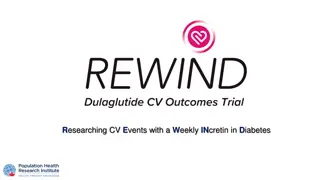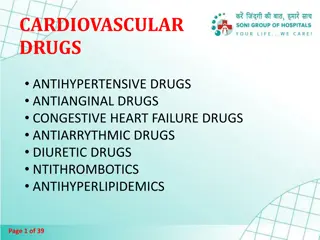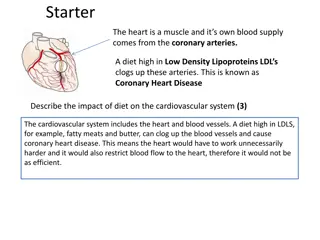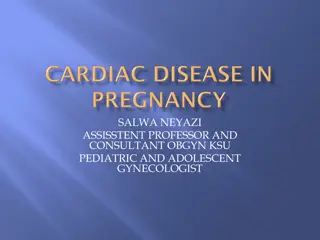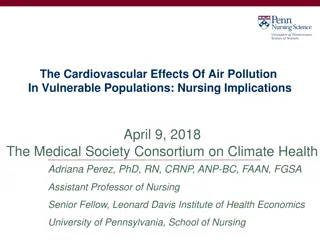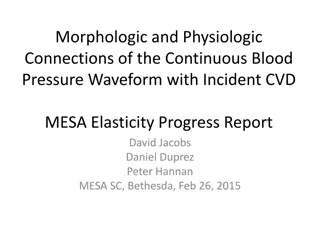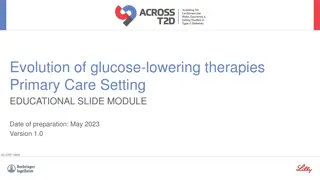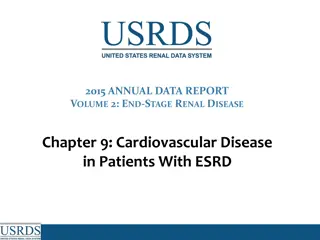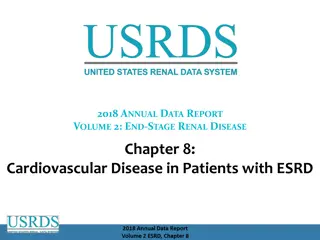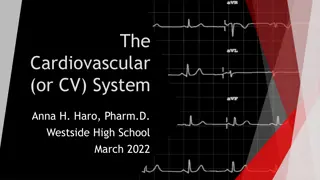Drugs Affecting the Cardiovascular System: Overview and Mechanisms
Explore the impact of various drugs on the cardiovascular system, including cardiac glycosides, vasodilators, anticoagulants, and more. Learn about the chemical nature and properties of glycosides and how they affect the heart's functioning.
Download Presentation

Please find below an Image/Link to download the presentation.
The content on the website is provided AS IS for your information and personal use only. It may not be sold, licensed, or shared on other websites without obtaining consent from the author. Download presentation by click this link. If you encounter any issues during the download, it is possible that the publisher has removed the file from their server.
E N D
Presentation Transcript
Drugs that affect the Cardiovascular System Presented by:- Dr.Archana Assistant Professor_cum_Jr .Scientist Deptt.Of Pharmacology & Toxicology Bihar Veterinary College, Patna
DRUGS ACTING ON DRUGS ACTING ONCARDIO VASCULAR SYSTEM CARDIO VASCULAR SYSTEM * Cardiac glycosides * Vasodilators * Haematinics * Anticoagulants * Antiarrhythmic drugs * Antihypertensive agents * Coagulant
CARDIAC GLYCOSIDES These are the glycosides naturally obtained from certain plants and contain active principles which act specifically on the failing heart and make them normal. That s why, they are called cardiac glycosides. All the cardiac glycosides have cardio tonic property. Cardiac glycosides are of plant origin : Part of the Plant Name of the plant Glycosides Digitoxin,Gitoxin & Digoxin Digitalis lanata Digitalis purpurea Leaves Leaves Digitoxin,Gitoxin & Gitalin Strophanthus gratus Seed Seed Strophanthin G (Ouabain) Strophanthin K Strophanthus kombe Urgenia maritima Bulb ProscillaridinA
CARDIOTONICS Cardiac tonic are those agents which improves the functional capacity of cardiac muscle, it has powerful action on myocardium and has great value in the treatment of cardiac failure, oedema of cardiac origin & cardiac asthma. Eg Digitalin, Digoxin, Ouabain etc.
CARDIOTONIC & CARDIOSTIMULANT : Cardiotonics Cardiostimulants (i) They increase both force of myocardial contraction and heart rate. (i) They increase force of myocardial contraction, but not heart rate. (ii) Increase the myocardial efficiency because the total myocardial oxygen consumption is not altered. (ii) They decrease the myocardial efficiency because the total myocardial oxygen consumption is increased (iii) They inhibit Na+ K+ ATPase enzyme and thereby slowly increase the cardiac contractility. Their duration of action is long. (iii) They act on their specific receptors to increase heart rate and force of contraction quickly. Their duration of action is short. (iv) In congestive heart failure (CHF) patient, they reduce the heart size by increasing the cardiac tone. (iv) They have no effect on cardiac tone and size. (v) They are mainly used to treat CHF. (v) They are mainly used to treat heart block.
CHEMICAL NATURE & PROPERTIES OF GLYCOSIDES * Cardiac glycosides are the combination of a sugar portion and aglycone (genin) The aglycone is chemically similar to steroids with an unsaturated lactone ring attached at C-17. the various sugars are linked to alglycon at C-3 position .It is the pharmacologically active portion of the glycosides. * The sugars modify the water and lipid solubility of the glycoside molecule and, thus affect its potency and duration of action. http://cdn.biologydiscussion.com/wp-content/uploads/2017/02/clip_image004_thumb-27.jpg
PHARMACOLOGICAL ACTION OF GLYCOSIDES Cardiac glycosides have the positive ionotropic effect on heart. They increase the force of contraction of myocardium & Decrease in heart rate. Its main action in congestive heart failure. Digitalis increases cardiac output & diuresis hence relief in oedema. Digitalis decreases the cardiac filling pressures ,venous and capillary pressures & heart size .
Sequence associated with CHF Increase the force of contraction of myocardium. Decrease in heart rate. Increase in cardiac output. Decrease in blood volume. Reduction in venous congestion. Increase in renal blood flow. Diuresis and relief in oedema. Return of heart size to normal. All these can be explained on the basis of +ve ionotropic effect of cardiac glycosides.
MECHANISM OF ACTION Cardiac glycosides inhibits the Na+, K+ AT Pase system(Na+ K+pump) located on the surface of myocardial cell membrane, and thus interfere with the Na+Ca2+ exchange resulting into intracellular accumulation of Ca2+ therefore more of Ca2+ions are made available to interact with contractile protein causing increase in force of contraction of myocardium as a whole. Na+, K+ AT Pase is the pharmacological receptor of cardiac glycosides.
Continued Cardiac glycosides inhibit Na/K adenosine triphosphatase, the sodium pump which causes more Na to remain inside myocardial cells Increased intracellular Na stimulates Na/Ca exchange that brings more Ca inside heart cells to increase the force of contraction Cardiac glycosides also stimulate the vagus nerve which decreases heart rate
CLINICAL USES Malfunctioning of heart. Congestive heart failure Atrial fibrillation Cardiac oedema Cardiac asthma Commonly used glycosides are digitoxin, digoxin and Oubain. Oubain is the most potent therefore used in emergency therapy, however is ineffective orally. NOTES :- * In ruminant parenteral digitalization is needed as the glycosides are ineffective after oral dosing. ( inactivation in rumen & reticulum) * It is rarely used in cat because of inducing emesis by stimulating vomiting centre in CNS.
ANTIARRYTHMIC DRUGS Antiarrhythmic agents, also known as cardiac dysrhythmia medications, are a group of drugs that are used to suppress abnormal rhythms of the heart.
DIGITALIZATION Administration of cardiac glycoside is known as digitalization. 3 types of digitalization in practice Intensive digitalization of calculated dose given immediately of calculated dose given 6 hr later 1/8 of calculated dose given every 4-6 hr Rapid digitalization- given in 3 divided dose at 6 hr interval. Slow digitalization- given in 5 divided dose at 10 hr interval.
Vasodilators & Antihypertensive drugs Vasodilators are a group of medicines that dilate blood vessels, which allows blood to flow more easily. The drugs which causes B.P to fall is known as hypotensive or antihypertensive drugs. Use hypertension, Heart failure, Angina In vety. Practice theses drugs are of limited use.
Drug Classes Used to Treat Hypertension Diuretics- Thiazides: Hydrochlorothiazide, High ceiling: Furosemide K+ sparing: Spironolactone, triamterene o o Sympatholytic drugs Centrally acting: Clonidine, methyldopa -adrenergic blockers adrenergic blockers and adrenergic blockers Labetolol and carvedilol Propranolol, metoprolol Prazosin, phentolamine Direct acting vasodilator drugs- Hydralazine and minoxidil, o Diazoxide & nitroprusside o Calcium antagonist drugs- Verapamil & diltiazem o Angiotensin-converting enzyme inhibitor and angiotensin Captopril, lisinopril., enalapril o Angiotensin receptor blocking drugs Losartan, candesartan
HAEMATINICS (Anti-anaemic) A hematinic are the drugs that required for the formation of blood cells in the process of hematopoiesis, and are used in he treatment of anaemia. Substances required for formation of blood Iron Folic Acid Copper Vitamin B12 Cobalt Erythropoietin- It is a glycoprotein hormone produced by the renal peritubular cells.
COAGULANT These are substances which promote coagulation and used for arresting haemorrhage. Locally acting haemostatics (a) Natural or Physiological haemostatics eg: Thrombin, Thromboplastin, Fibrin, Fibrinogen (b) Synthetic local haemostatics eg: Absorbable gelatine sponge, oxidized cellulose, Astringents Systemic bloods coagulant eg : Whole blood, Vitamin K, Protamine sulphate, Epsilon Amino CaproicAcid (EACA), Tranexamic Acid
ANTICOAGULANT These are drugs used to prevent blood clotting. Classification based on use in vitro or in vivo In vitro anticoagulant (i) Sodium oxalate (ii) Sodium citrate (iii) Sodium EDTA In vivo anticoagulant (i) Heparin- used parenterally (ii) Coumarin derivatives- used orally. Eg-warfarin, phencoumon


